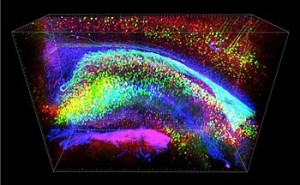Brain research, in many ways, can be regarded a field still in its infancy, making it ripe for the exaggerated claims, myths and stereotypes that threaten to discredit the value of real scientific progress. To celebrate Brain Awareness Week and shed light on some of the major recent advances that are set to change lives in the years to come, we called upon our neuroscience and neurology editors for their thoughts in response to the following question: ‘What advancements in the past 2 years do you anticipate will have the biggest impact on people’s lives?’
From see-through brains to personalised medicine in psychiatry, here is a collection of extracts from their responses, serving to highlight the progress and benefits of various areas of brain research, through the eyes of experts in the field.
Evolving technologies in neuroscience

“A new technique called CLARITY was developed by Karl Deisseroth and his team at Stanford University, which makes the brain transparent, thus contributing to the understanding of microscopic structure of the brain at microcircuit level… deep brain stimulation has been shown to be effective in controlling severe forms of depression and Parkinson disease… and genome studies, combined with iPS stem cell research, have revealed many genes and molecular mechanisms linked to psychiatric disorders.”
– Bong-Kiun Kaang, co-Editor-in-Chief, Molecular Brain
To read more about how deep brain stimulation may help alleviate depression, read our research synopsis in Biome.
“Without a doubt, the most amazing advancement in behavioural neuroscience in the past two years has been as a result of the work of Karl Deisseroth. Optogenetics, the technique that he developed to study the effects on behaviour of single cell stimulation/inhibition, has revolutionized our thinking and taken our understanding of brain and behaviour to the next level. He and his collaborators have shown that behavioural patterns that are relevant to a range of psychiatric disorders can be controlled by dynamically modulating specific neuronal projections…. Altogether, an outstanding contribution to neuroscience research.”
– Vivienne Russell, co-Editor-in-Chief, Behavioral and Brain Functions
“We believe that one of the most exciting, promising and provocative advancements in brain research is the Restorative Encoding Memory Integration Neural Device (REMIND), a form of brain-machine interface that encodes, predicts and produces patterns of neurological activity for specific memories…The project, funded by the United States’ Defense Advanced Research Projects Agency (DARPA) offers new hope for individuals with certain types of traumatic brain injuries, stroke, and perhaps forms of neurodegenerative disorders that induce dementia, and also raises neuroethical issues, questions and discourse focusing upon possible ways that such technology can- and should – be employed.”
– James Giordano and Kevin Donovan, co-Editors-in-Chief, Philosophy, Ethics, and Humanities in Medicine
The use of biomarkers in diagnosing Alzheimer’s

“It is generally acknowledged that Alzheimer’s disease is an insidious process that has a long silent phase during which pathology builds long before symptoms… Using biomarkers related to brain pathology and biochemistry has enabled a more detailed timeline of preclinical stages of Alzheimer’s disease to be charted…Several amyloid PET ligands have been approved… and will soon enter the clinical arena. Clinical utility studies, although few in number, have all shown that clinical diagnosis and confidence in clinical diagnosis will change by using these new methods.”
– Todd Golde, Doug Galasko and Philip Scheltens, co-Editors-in-Chief, Alzheimer’s Research & Therapy
For a full account of the editors’ perspectives, read our special Biome Q&A. You can also get to know more about the search for biomarkers in Alzheimer’s disease in our podcast with Douglas Galasko, Editor of the Peripheral Biomarkers special series, and in our Q&A with authors Jamie Toombs and Henrik Zetterberg on their research on biomarkers measurement, published in Alzheimer’s Research & Therapy.
Insights into brain fluids and barriers
“In the field of brain fluids and brain barriers, the most important recent advances and still-advancing areas of research include new methods to deliver drugs through the blood-brain barrier to treat brain tumours and other neurological diseases; a revision and extension of the classical view of fluid circulation within the brain, enabled by new imaging techniques, and leading to revised views on the distribution within and clearance from the central nervous system of endogenous and exogenous substances; and the development of agents to prevent blood-brain barrier dysfunction in neurological disease.”
– Richard Keep and Hazel Jones, co-Editors-in-Chief, Fluids and Barriers of the CNS
The ‘prion-like’ spread of neuropathology
“The recent identification of a prion-like spread of pathology as a common denominator for several disorders like Alzheimer’s and Parkinson’s disease has pushed the neuroscience research field to more closely look into mechanisms that may unify clinically distinct neurodegenerative diseases. Heparan sulfate proteoglycans, cell surface molecules that closely resemble heparin, were recently found to mediate the cellular uptake of aggregated protein seeds resulting in propagation of brain pathology underlying different neurodegenerative disorders. These recent findings, we believe, offer new opportunities to combat disease progression of various neurodegenerative disorders by targeting the same pathways.”
– Guojun Bu, Huaxi Xu (Editors-in-Chief) and Henrietta Nielsen (Managing Editor), Molecular Neurodegeneration
Lifestyle patterns and neuropathology

“It has been increasingly recognized that neurological disorders, such as Alzheimer´s, Parkinson´s and stroke, are not only determined by unfavorable biology and genetics, but are highly influenced by adverse lifestyle patterns, such as smoking, obesity, low education, and reduced cognitive, physical and social activity. Behavioral, cellular and molecular mechanisms underlying beneficial and detrimental environmental effects on brain pathology represent an attractive focus of recent interdisciplinary research. This is eventually expected to affect prevention and treatment of the most common diseases.”
– Werner Paulus, Editor-in-Chief, Acta Neuropathologica Communications
For a more detailed overview of this emerging concept, read Acta Neuropathologica’s special issue on lifestyle neuropathology.
Focusing on early development in autism
“ An important area of research over the last few years, in neurodevelopmental disorders and autism in particular, has been the focus on early development. Recent developments include molecular genetics studies that have revealed the timing of expression of ‘autism susceptibility genes’ during the mid-foetal period.

Behavioural and neuroimaging studies have begun to demonstrate that autism unfolds during the first few years of life, following a period of relatively typical development. This behavioural unfolding is accompanied by concomitant changes in brain metrics, observed
through imaging, electroencephalography (EEG) and event-related potentials (ERP), which are likely to provide insights into brain mechanisms underlying the onset of autistic behaviour as well as specific biomarkers for early detection.”
– Joseph Piven, Editor-in-Chief, Journal of Neurodevelopmental Disorders
You can continue reading on the latest developments in autism research in our Biome Q&A with Joseph Piven.
Personalised medicine in psychiatry
“Should we assess every risk possible? Risk assessment has become an important topic in psychiatry and a growing research field in different indications. We do risk assessments for patients at risk of psychosis as we would for those at risk of developing Alzheimer’s disease. But once we know the risk, how do we inform patients and what impact does it have? A recent article published in the American Journal of Psychiatry found that those who knew their positive risk status for Alzheimer’s not only judged their memory worse but also performed worse on the objective test in comparison to those who unknowingly had the risk allele. Based on these results, we should carefully revisit and reconsider our future efforts concerning risk assessments.”
– Florian Seemüller, Section Editor, BMC Psychiatry

“Although several psychological and pharmacological treatment options are available for anxiety disorders, not everyone responds well to each option and finding a good treatment fit can take many months or longer. Recent studies have begun to use structural and functional neuroimaging measures to help predict treatment response in anxiety disorders. Although the literature is currently small, pre-treatment neuroimaging measures show great promise, and future research will be needed to determine the relative predictive power of neuroimaging measures as compared to clinical and demographic measures.”
– Lisa Shin and Ahmad Hariri, Editors-in-Chief, Biology of Mood & Anxiety Disorders
Find more information on the current challenges and controversies in personalized medicine, take a look at our BMC Medicine review and our Biome podcast with Claire Barnard and Eric Topol.
Changing directions in psychology
“I think that the most important change to have happened to psychological research in the past two years is not a theoretical advancement. It’s been the realisation that the field needs to change and improve upon research practices and statistical rigour. Psychology is now leading the way in making reforms to the scientific research and publishing process that will have a huge impact on future research in many areas of science.”
– Peter Etchells, Associate Editor, BMC Psychology
Sex-based differences in neuroscience, neurology and psychiatry

“Greater attention is being paid to the sex of people with neurological and psychiatric disorders. A particular example concerns the increasing and converging lines of evidence showing that Alzheimer’s disease impacts men and women differently. Two-thirds of people diagnosed with Alzheimer’s disease are women; and remain disproportionally prone to Alzheimer’s even after adjusting for their longer life expectancy. Crucially, diverse evidence from brain imaging, post-mortem analyses, hormone therapy, genetics and neuropsychology all converge on the idea that Alzheimer’s disease affects men and women differently. Future assessment of sex-based differences in cognition may be critical in contributing to the diagnosis and treatment of such conditions.”
– Keith Laws, Section Editor, BMC Psychology
Learn more on sex-based differences in cognition and other neuroscience-related topics in our dedicated journal, Biology of Sex Differences.
-This blog post has been prepared and edited by Elizabeth Bal-
Latest posts by Natalia Manrique (see all)
- Advances to watch in brain research – a collection of editors’ perspectives - 13th March 2014
- Brain Awareness, everywhere! - 10th March 2014
Comments